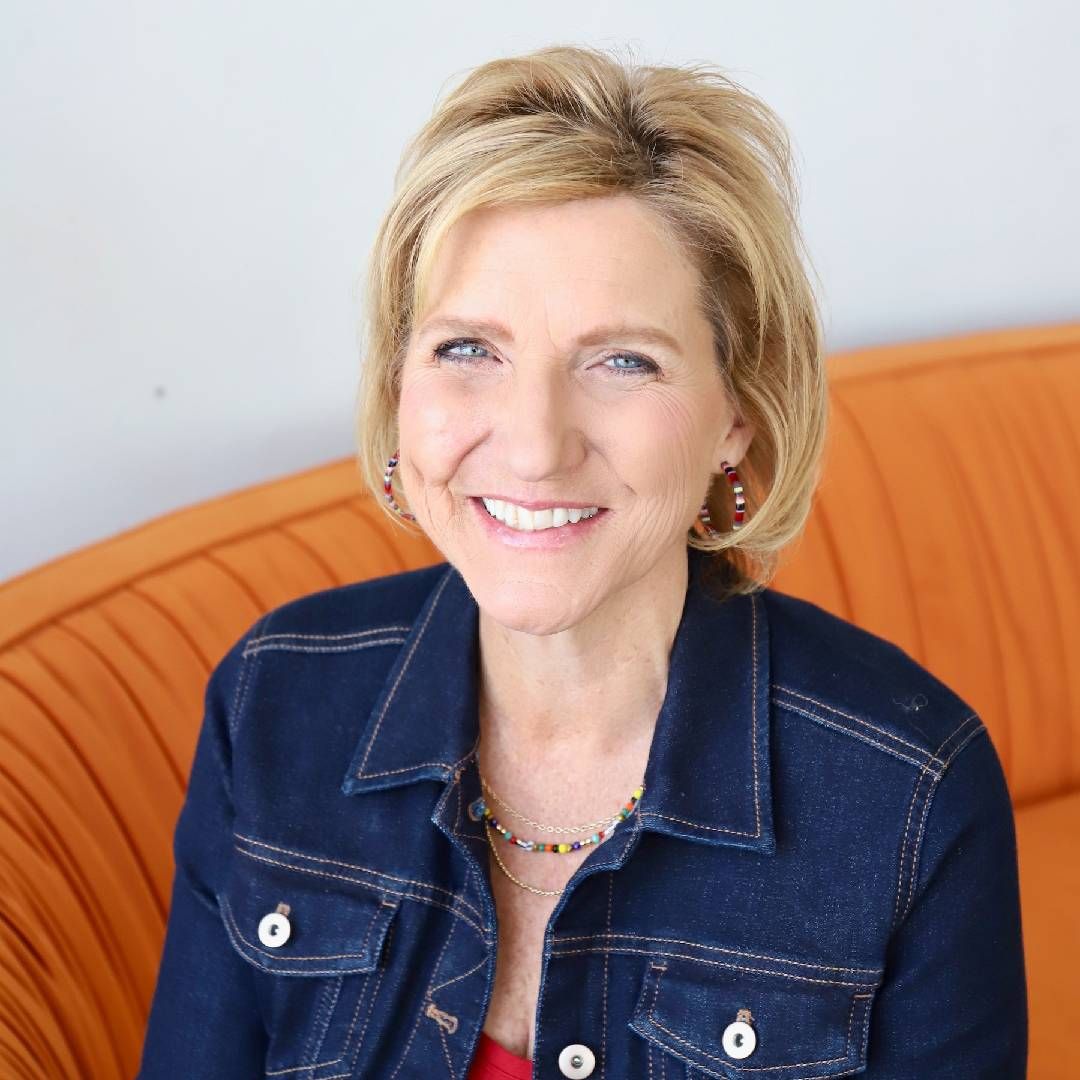Jan Golden: Creatively Celebrating Joyful Aging
The founder of Age-Friendly Vibes has developed a line of greeting cards and gifts to promote positive aging
The sentiment: "Your chariot awaits. Happy Birthday." The image: a drawing of a walker.

We've all seen birthday cards that mock aging, refer to the recipient as being "over the hill" or forgetful. A birthday marks another year in someone's life and should be celebrated, not denigrated and mocked.
As Jan Golden, founder of Age-Friendly Vibes, grew more aware – and concerned – about the prevalence of ageism, she decided to use her skill as a web developer and her eye for design to create a line of greeting cards and gifts that would promote age positivity and launch conversations about the beauty and benefits of growing older.
"My cards all have little jumping off points for a discussion about age. I'm really proud of promoting that moment as a powerful opportunity that you get once a year with your loved one or friend to have a conversation," Golden said. "Something like, 'I'm feeling good about getting older - how do you feel about it?'"
"The ageism in greeting cards has just been sitting out there with nobody really addressing it and [I'm] saying, you know, this is not okay anymore."
Next Avenue recently spoke with Golden, whose cards are available at locations such as Barnes & Noble and Paper Source (and on her website) about the inspiration behind Age-Friendly Vibes and what she's learned about ageism the more she's gone up against it.
"The ageism in greeting cards has just been sitting out there with nobody really addressing it and [I'm] saying, you know, this is not okay anymore," said Golden.
This interview has been edited for length and clarity.
The Inspiration Behind Age-Friendly Vibes
I had this entrepreneurial quest when my parents both passed away and I turned about 50. I think that legacy component kind of kicked in. I was in the tech field and I thought 'I need to do something a little bit more with my life.' I started blogging about iPhone training and I became aware of ageism when I was teaching tech to older adults and also became aware of how difficult it was for people in their forties and fifties to secure employment. That was happening to me as a woman in tech who was older.
At that time, Ashton Applewhite was launching her book called "This Chair Rocks." I was fascinated by this topic of ageism. It was the first time that I ever really became aware of it. And what they say is that once you become aware of ageism, you see it everywhere.
Connecting with Changing the Narrative
I live in Denver and Changing the Narrative is an anti-ageism campaign based here, led by Janine Vanderburg. I attended several anti-ageism events. During the pandemic, they sponsored their first anti-ageism birthday card contest, which was really intriguing to me. At that time, I was a Change Agent, one of the people trained by the organization around reframing aging. I didn't participate in that first contest because I was more of an advisor with the group.
"If you searched for clever or funny or snarky cards, you just got these horrifically ageist cards by the very large makers."
But what I did do was create my first line of anti-ageism greeting cards. I was using my design skills, my tech skills and everything that I learned (from the anti-ageism events and also from reading Becca Levy's book, "Breaking the Age Code"). I put some cards up on Etsy and they were a huge success. That was the start of my business: designing age-positive cards that counteracted or diluted the effect of ageist birthday cards that were out there.
On Doing the Research
If you searched for clever or funny or snarky cards (about getting older), you just got these horrifically ageist cards by the very large makers. We're talking Hallmark and American Greetings, all front and center on the shelf.
I knew I needed to learn everything I could about the greeting card industry. It's a $6 billion (per year) industry and it's complex: there are over 2000 individual makers like me but Hallmark and American Greetings control about 8% of the greeting card industry, which is huge.
Breaking Into the Greeting Card Industry
When you get yourself involved in the greeting card industry, like any other industry, they want to make sure that you have staying power and capacity. The Barnes & Noble and Paper Source orders were thousands of cards ordered at one time instead of 10 or 20. (laughs). It was a challenge at first, but I've been able to overcome that and I now have a lot of credibility. I'm very proud of my design recognition. (In 2023, Golden was named one of 10 Designers to Watch by Stationery Trends, an industry publication, and she has a new licensing agreement with UK Greetings, a division of American Greetings.)
Building Awareness for Age-Friendly Vibes
I'm growing at a pretty rapid pace from the greeting card industry perspective, but every year there are new layers. I need to hire some people in this coming year to help with design and concepts. It's a business that just checks all the boxes for me. I'm able to be creative and I have the ability to make a difference in people's lives. Not only recipients of the cards, but my peers and the industry as a whole.
At the first trade show I did, I had two makers on both sides of me that were successful designers, but they had some ageist cards in their collections. I didn't want to chastise them or be really aggressive, so instead I showed them some of my cards and said, 'here's an alternative.'
"With an ageist greeting card, it's not just your best buddy that's seeing it, or your sibling, it's your hiring manager, your health care worker, marketing executives writing ads."
Many designers are younger than me – I started this at 60 – so I was feeling the effects of ageism myself. But they looked at my cards and started saying 'I had no idea (how ageist messages could offend).' Some of them took down their ageist cards at the trade show. And since then, some of the younger designers have created cards with age-positive messages for Changing the Narrative.
Honoring Caregivers and People with Dementia
I'm thrilled about a collaboration with Ashley Stevens, The Dementia Guru. I met her at the American Society on Aging (ASA) conference last year. We had been following each other online, and we had coffee and I said, 'we need to figure out a way to support caregivers and bring awareness to dementia because so many people are affected.' Caregivers in this country are not acknowledged, not appreciated and not recognized the way that they should be. We developed a line of caregiver appreciation and dementia awareness merchandise.
The topic is near and dear to my heart since my mother-in-law recently passed away from dementia. Like many people, I understand the impact of that disease firsthand. So in addition to age-positivity, Age-Friendly Vibes can address other issues impacting older adults. (Golden also donates a portion of the proceeds from her sales, either in-kind or monetarily, to several anti-ageism organizations including the Ruth Park Foster Center for Abundant Aging and Justice in Aging.)
A Backlash on Criticizing Ageist Humor
Ageist humor is a juicy topic. Partly because of the number of people who use it as a way to connect with people, with their college buddies, with their siblings. You know, the 'we're the two old biddies' kind of thing. And there's been backlash from people saying 'why are they trying to take away our funny birthday cards?'
First of all, ageist humor is part of everyday ageism, and we see that 80% of people report seeing (ageism) every day. It's the subliminal messages about getting older, being declined, depression, dementia, etc. With an ageist greeting card, it's not just your best buddy that's seeing it, or your sibling, it's your hiring manager, your health care worker, marketing executives writing ads. It's contributing to this trickle effect of the ageist messages that we're seeing.
So, should we really be laughing at those types of things knowing the harm that ageism does when it comes to our ability to find jobs, our longevity and all the research people like Dr. Becca Levy have done? What is self-deprecating humor really doing to us?
Education and awareness are still needed. There are still people who really aren't aware of the damage and harm that ageist humor is doing.


